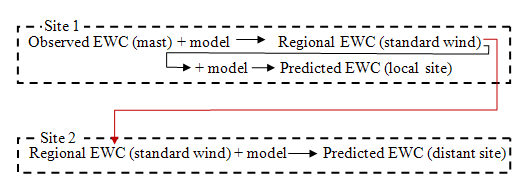Extreme winds
WAsP Engineering extreme winds
WAsP Engineering predicts extreme wind climates at turbine sites from Observed Extreme Wind Climates (OEWC) based on measurements at reference masts. This is done by the deflection and speedup factors calculated by the included flow model, first resulting in a regional extreme wind climate (REWC) from which finally the Predicted Extreme Wind Climates (PEWC) are deriveded as sketched below.

In the absence of local reference measurements of sufficient duration, a remote reference site may be used. The regional extreme wind climate (REWC) is representative for a larger region, referring to standard conditions of 10 m above a uniform flat terrain with a surface roughness of 0.05 m. The conversion from OEWC to REWC is done by the Geostrophic drag law – similar to the way WAsP converts observed wind climates to wind atlas (regional wind climate) files. The REWC may be stored in a file and used as input in a second WAsP Engineering project to model wind conditions at a planned wind farm, as also indicated in the sketch above.
The OEWC is made using the WAsP Climate analyst which is shipped with WAsP as well as WAsP Engineering. Sometimes it is hard to find reference data, even for a large region. As a substitute, and only for some parts of the world, Risø has calculated REWC files by NCEP/NCAR reanalysis data, see here.
The WAsP Engineering extreme wind model is based on the Gumbel distribution and fitted by annual 10-minute maxima using probability-weighted moments. This allows extrapolation to longer return periods (blue line in below plot) with uncertainty estimates (grey lines). The flow model predicts site-specific annual maxima with corresponding wind direction at the selected sites and heights, and then the Gumbel fit is derived. The uncertainties will be large if the Gumbel slope parameter (alpha) is large and if the number of observation years are too few. The IEC 61400-1 standard recommends at least seven years.

